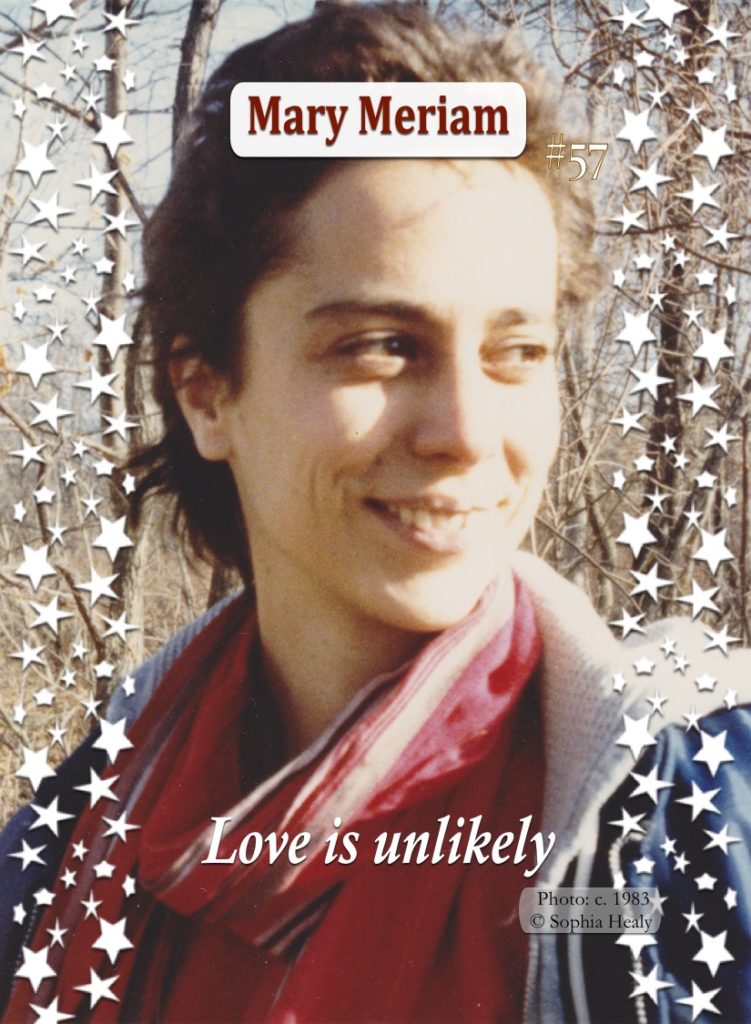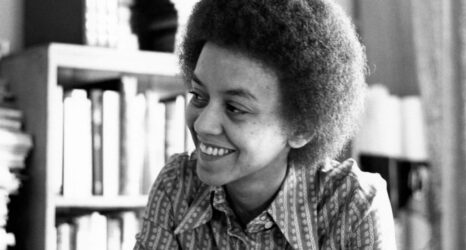Coming out doesn’t make you at home in the world; nor, certainly, does sex. You need bonds beyond sex: a community, a culture, a shared set of obsessions.
“Love on the March,” Alex Ross, The New Yorker 11/12/12
When I was a young lesbian in rural New Jersey in the ‘70s, I was completely lost in a dark sea and sky—without stars, sun or moon to guide me. The word “lesbian” was only uttered, when it was uttered at all, with contempt and mockery. There appeared to be no place for me in society and culture, and to express myself would be dangerous. I wrote poems, and kept my poems private: a community of one.
Then I saw two words in the Village Voice that pierced through the fog: Lesbian Nation. A whole nation of people like me!
It’s 2020, and I’m still sharply attuned to Lesbian Nation, especially the poet part of the population. Where are the stars, sun and moon of lesbian poets? I look for you always. I love most those lesbian poets who are fearless and inclusive and complete, who don’t censor themselves. Let me share your voices with the world. So I did, starting Lavender Review and Headmistress Press.
This year, Headmistress Press is proud to announce the inaugural Sappho’s Prize in Poetry, awarded annually for one full-length poetry collection by a lesbian. To celebrate and promote this prize, I’m posting a series of short monthly book reviews or interviews here on msmagazine.com.
Full disclosure: I’ve published some of these poets in Lavender Review, though I haven’t published any of their books. Headmistress Press made Lesbian Poet Trading Cards for some of these poets. Some of these poets have served or will serve as judges for the Headmistress Press Charlotte Mew Chapbook Contest.
Vi Khi Nao and Naomi Replansky were the first two poets in this series.
Sarah Sarai—whose latest book is That Strapless Bra in Heaven (Kelsay Books, 2019)—suggested that I should be interviewed by poets I’ve published in Lavender Review.
She solicited questions from R. Nemo Hill, Jan Steckel, Leonard Kress, Risa Denenberg, Lynn McGee and Joy Ladin. I had my own queer ideas about how to respond.

Where do you find meter, Mary? Many poets I dislike seem to impose it on language—but in your work I find the sort of meter that is more to my liking: discovered within language. Where in the world, in the body, in nature, do you find evidence of it? Identity Politics rules much of the poetic roost these days. While I support the emergence of long-suppressed voices, I also support the dissolving of the self in the poetic. You seem, remarkably, Mary, to do both at once. How does one find oneself by losing one’s self? I know you live a somewhat isolated existence, compared to many poets who congregate in cities where it seems so much more is going on artistically. I know this isolation has caused you no small amount of anguish in the past. Can you comment, Mary, on the fruitful persistence of your figure in your landscape? Are poets social or solitary animals?
MARY MERIAM:
I love the horses’ clops and carriage wheels
on cobblestones, and evil tapping heels,
patterns of eerie sounds in stories told,
with closeted Jeremy Brett, deduction bold,
as Sherlock Holmes. In closets, shoes stay dumb.
But coming out, I beat my sidewalk drum
and practice breathing with my wounded heart
until my rhythmic reason turns to art.
Nemo, the city killed me. See me lost
as flower pollen in a late-spring frost,
without a breeze or bees to carry me,
frozen, excluded from a family tree.
What could I do as no one’s darling daughter,
but find myself fresh air, whole food, clean water?
Slowly a pulse returned. I took my pen
to write my pulse, and learned to count to ten.
I am thrilled to see where your literary career has arrived despite (or perhaps because of) your voluntary isolation in rural America. Are you as satisfied with it as I would be? Are there things you feel you could have accomplished better if you had stayed in New York? Conversely, what are the advantages that the rural life gave you when it came to self-knowledge and your writing?
MARY MERIAM:
What heights I’ve reached I can’t imagine, Jan.
Boosted by some balloon without a plan,
holding the skinny string, not looking down,
dodging a verb, I float with clouds of noun.
I wash the dishes, watching herons, crows,
and eagles paint the lake with flutter prose
which I will bake with mountains in the spring
to make my poem out of claw and wing.
Persist is what I do. I have no ease
on grass or pavement. Here, at least, the trees.
The trees teach me their tongue and bark. They say
I shouldn’t move to Oakland and be gay.
They seem to want to mingle with my roots.
Their branches give me leaves and nutty fruits.
If anyone, the oak deserves bouquets
of fancy prizes, gratitude, and praise.
I wonder if you would address the ways in which lesbian poetry differs from non-lesbian writing. If in fact it does, is it related to poetics, form, subject, the writer or persona, a combination? Do you see your formal poetry—sonnets and such—as a continuation of the formal tradition or a departure/disruption from it? Rhina P. Espaillat described your writing as “fearless.” And there’s a quote on your website from Mark McDonnell, “She doesn’t appear to be afraid of anything.” My question is—what do you fear?
MARY MERIAM:
She hotly kissed her hot girl. Now alone
in dark so dark, the kiss seems still unknown,
paper and pen will tell how dark is dark.
Without an alphabet, she makes a mark,
gives birth to fire and a tiny star.
The literary universe so far
thrives ignorant of her and her hot kiss,
except for Sappho, eons safe from this.
Fumbling through dark, she seizes on a form,
a blazing sonnet, built to make her warm
to writing in the dark. It wraps its lines
around her mind, its rhymes appear like signs,
it heals the Sapphic fragments, sings her out
of hiding, glimmers like a cosmic scout,
and spins a set of clothing that coheres
her singing, lights the dark, and bites her fears.
What was the good, the bad and the ugly during your years in the MFA program at Columbia University? What (or who) drew you to formal poetry?
MARY MERIAM:
I wore my running shorts to class one day,
trying to tell them something naked gay,
but all those eyes of disapproval buzzed
at me, a silent lesbian, unloved.
And Jane’s friend Muriel was still alive,
and Marilyn had just begun to thrive,
but I was stuck with Poets Laureate,
jammed in a closet, uninspired, arid,
trashing my efforts into fragments, split
between my love-life’s poetry and biz.
I couldn’t curry favor, sleep with them,
or charm them with my rented room’s poem.
That was the end of school, and so I sank,
a struggling, starving stray who owed a bank.
I sat and waited. Breath and rhyme arrived,
the heartbeat of pentameter survived.
Do you think you’ll ever expand the Lesbian Poet Trading Card concept to other types of products; something dignified, like your trading cards, that wouldn’t trivialize the writers? Will the Headmistress Press Poetry Party scheduled for May 30, 2020 in Arkansas be repeated in other cities? In a 2019 interview on The Best American Poetry Blog you were asked, “What is one thing American poetry needs more of, in your opinion?” and you said, “Some bitch like me.” What distinguishes a bitch like you from all us other bitches?
MARY MERIAM:
Headmistress dances slowly on the beach,
and slowly marks her pupils’ parts of speech,
more activist than commerce. She will place
your lovely thoughts inside her pencil case,
and hope that if a bright plan dawns on you,
just send it, and she’ll see what she can do.
And now Headmistress, by the way, would like
to thank co-founder Risa, praise the dyke
for generosity to every Mistress
and turning this into a caring business.
I want the power in the hands of bitches,
to edit giant journals, publish witches,
to chair illustrious contests, dish out gold,
to tell our gorgeous rage still left untold,
to let the pompous patriarchy wait
while bitches fix the world and celebrate.
You have had an intense—I would say intimate—relationship with Amy Lowell’s work. How did this relationship begin, how did it blossom and what did you learn about Lowell and your relation to her as you wrote Lady of the Moon?
MARY MERIAM:
I asked LF for her advice, for who
to write about, a married female two.
Amy and Ada, two figures in the air.
I’d write about them as a form of prayer
that one day marriage would be legal here.
I eyeballed LF’s essay, drenched my ear
with Amy’s poems, took a daily bath
in both for months before I picked my path.
It’s time to trust I’ve filled my reservoir
with voice and details, time to tilt the jar.
This poet is a brilliant fighter, free
in love with Ada since no one could see.
One hundred years ago, a sister wrote
the truth about her lesbian lifeboat,
and for her tender, brave, and lovely work
the macho critics buried her in smirk.





